Dr. Eric Godwin Silas – the legend 1928 – 2018
The Indian Fisheries and Aquaculture sector of the country faced the ever seen irreparable and irreplaceable loss on 27th April’18, with the demise of the great fisheries legend Dr. Eric Godwin Silas at Cochin, Kerala. A widely respected personality and eminent scientist, Dr. E. G. Silas was the harbinger of the vision that sustained the fisheries and aquaculture research of the country. He passed away peacefully at the age of 90 at Lakeshore Hospital, Cochin with his friends and family around.
Dr. Silas donned many roles during his illustrious and seamless career that spanned over 6 decades; He was the former Vice Chancellor, Kerala Agriculture University,former Director, Central Marine Fisheries Research Institute and the founder of the prestigious institute, the Central Institute of Brackishwater Aquaculture (CIBA). He played a pivotal role in setting up of other fishery research organizations too, such as the National Bureau of Fish Genetic Resources (NBFGR, ICAR) at Lucknow and the Centre for Marine Living Resources (CMLRE), when the country’s fisheries and aquaculture education was in its nascent stage. Dr. Silas was also closely associated with the Aquaculture Spectrum and was the Chairman of the advisory committee of the magazine.
Dr. Silas remained active till his last days, participating in important conferences and seminars, heading the advisory committees of various organizations, besides pursuing his passion in photography and painting. In fact, he worked till the date he went to the hospital.
Association with the Aquaculture Spectrum
Dr. Silas was the Chairman of the Advisory Board of the Aquaculture Spectrum and a mentor to its team. He used to critically review each edition and constantly provide inputs and suggestions for its improvement. He was a well-wisher and a personal mentor to me and our team at Aquaculture Spectrum.
While we were students of Mariculture at the Central Marine Fisheries Research Institute, we were unable to interact with Dr. Silas who was then the Vice Chancellor of the Kerala Agricultural University. My first interaction with Dr. Silas was during the Scientific Advisory Committee (SAC) meetings of Rajiv Gandhi Centre for Aquaculture (RGCA), where he was the Chairman of the SAC. He had a thorough understanding of all RGCA programmes and often visited the projects to update himself on the activities there. He was a person who was much concerned about the welfare of the staff. Whenever there was a cyclone or a spell of bad weather, he was the first to call and enquire about the safety of the staff and the facilities at various RGCA centre. He made sure that he got an update from us from time to time. He was a great motivator and an inspiration to all of us.
In my latest interaction with him, he emphasized on gender inequality in the Aquaculture sector and the need for skill development among the younger generation
Dr. Eric Godwin Silas – the legend
Dr. Eric Godwin Silas, born on 10 January 1928 at Demodhera, Ceylon (Sri Lanka) completed his schooling at the St. Josephs English High School, Thiruvananthapuram, Kerala; his Intermediate in American Mission College, Madurai and graduated from Madras Christian College, Tambaram, Chennai. After graduation, he completed a two years B.Sc Honours Course at Christian College and registered for the Masters Degree in Science through research with the Madras University under guidance of Late Dr. Sunder Lal Hora, the then Director of the Zoological Survey of India, Calcutta, for which Degree was awarded to him in 1951. He obtained his Ph.D., in 1954 and was awarded D.Sc., Degree of the Madras University in 1972.
During the initial days of his illustrious career, he carried out surveys of the watersheds of the Western Ghats from Tapti River southwards to Kanyakumari to study the hill stream fishes. His revision of fish taxa from the rivers and lakes of the Himalayas, Central Asia – eastwards to China and south to Myanmar, Malaysia and Indonesia combined with his work on fishes from the Western Ghats helped him to contribute to Hora’s Satpura Hypothesis of the occurrence of fishes of Malayan affinities in the Western Ghats. His interesting publications include one on “Speciation among the Freshwater Fishes of Ceylon” presented at the International Symposium on Organic Evolution held by NISI (now INSA) New Delhi in 1951. His revision of new fish taxa and descriptions of new genera and species of freshwater fishes has stood the test of time.
Prior to being appointed in 1963 as Marine Biologist in erstwhile Central Marine Fisheries Research Station, Mandapam Camp, Ministry of Agriculture, GOI., Dr. Silas served as Honorary Scientist, and as Curator / Registrar of the Bombay Natural history Society and Natural history Section of Prince of Wales Museum, Mumbai which gave him an opportunity to be associated with many eminent and well known scientists in the country and abroad. As Curator, he was privileged to work with the renowned Ornithologist, Dr. A. Salim Ali. His Post-Doctoral work in the USA was with Dr. Carl L. Hubbs, doyen of fishery science, at the Scripps Institution of Oceanography, UCLA. La Jolla, CA.
Venturing into unexplored frontiers
At Mandapam, CMFRI, Dr. Silas started work on Tunas from the Indian Seas, an area which was not in the programme of the Institute. It however was in tune with his desire to traverse “unchartered grounds”, face challenges and discover new things. As Marine Biologist, he nurtured several Ph.D. programmes on primary and secondary production based on oceanographic work and biological samples collected from the Indian Seas during the cruises of R.V. VARUNA, many of which he led and participated in. Among his many findings from the Shelf waters, Continental slope and oceanic waters was the study of the Deep Scattering Layers and its constituents. His Report on the “THE EXPLORATORY FISHING BY R.V.VARUNA”conducted by him and published as Bulletin 12 of CMFRI in 1969 is a precursor to what we call today as “ecosystem based fisheries.”
Dr. Silas also actively participated in a four month tuna long-lining cruise in the Indian Ocean on board the U.S. Research Vessel ANTON BRUUN during the International Indian Ocean Expedition in 1964. Fervour for sea life is ingrained in him as even at the age of seventy he spent more than a month on a Korean Fishing vessel M V AL SARAWAT fishing from the Wadge Bank northwards to Kori Bank and in the Lakshadweep Sea.
The Mariculture projects and programmes in CMFRI were initiated by Dr. Silas as Head of the Marine Biology and Oceanography Division. Once he assumed charge as Director of CMFRI in June 1975, the developments in research on capture fisheries and mariculture received a boost. Many Inter-organizational collaborative programmes were initiated by him and one such on remote sensing on the west coast of India in collaboration with SAC, NARSA and FSI was the first of its kind towards helping in fishery forecast.
Dr. Silas served as the President of the Marine Biological Association of India and also functioned as the Editor of its Journal. During the stint, he convened the International Symposia on Scombroid Fishes; Endangered Marine Animals and Marine Parks; on Indian Ocean and Adjacent Seas and on Coastal Aquaculture and published the proceedings of these.
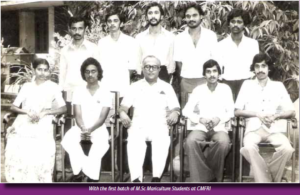
Builder of Institutions
Dr. Silas has been a builder of Institutions in Fisheries and Aquaculture, Marine Sciences and Ocean Research, Agriculture and Natural history. Perhaps no other individual personality in modern India could be compared to him. His foresight and vision on the requirements of the country for the next century is implausible.
Upgrading the Central Marine Fisheries Research Institute under his directions into a World Class Centre of Research, training and Extension by improving the physical infrastructure of land, buildings, laboratories and amenities, as well as developing trained manpower, both Scientific and Technical of high competence and calibre is well known. Two of the Units he developed at CMFRI, budded and grew to become National Research Centres, namely, The National Bureau of Fish Genetic Resources (NBFGR, ICAR) at Lucknow and the Centre for Marine Living Resources (CMLRE) for looking after and managing the research programmes of FORV SAGAR SAMPADA presently under the Ministry of Earth sciences, Government of India.
Dr. Silas was the Officer on Special Duty for the Establishment of the Central Agricultural Research Institute (CARI, ICAR) at Port Blair, Andaman and Nicobar Islands. He was also the Founder Director of the Central Institute of Brackishwater Aquaculture (CIBA, ICAR) at Chennai. Being Founder Chairman of The Salim Ali Centre for Ornithology and Natural History (SACON) under the Ministry of Environment, Forests and Wildlife, GOI for five years from its inception in 1991, he moulded it to grow as a National Centre of excellence in Ornithology and Forest and Wetland Ecosystems. He has also served as Chairman, Marine Products Export Development Authority, (MPEDA), Cochin under the Ministry of Commerce and Industries, GOI.
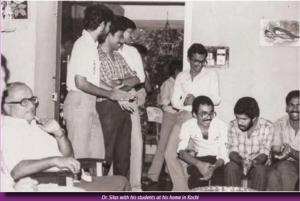
Contribution to Fisheries Education
Dr. Silas’s role in higher education in fisheries in the country is equally important. He was responsible for starting and nurturing a unique programme aided by UNDP/FAO/ ICAR as a Centre of Advanced Studies in Mariculture at the CMFRI in 1979 for Masters (M.Sc Mariculture) and Doctoral (Ph.D. Mariculture) Degree programmes and this was an outstanding success. As of today, five of his students,who have come out of this programme become directors of various ICAR Fisheries Institutions (Dr. A. Gopalakrishnan, Director of CMFRI, Dr. P. Jayasankar Director of CIFA, Dr. J.K. Jena and Dr. Kuldeep Lal became Directors of NBFGR and Dr. K.K. Vijayan, Director of CIBA). Dr. J.K. Jena, later went on to become the Deputy Director General (Fy), ICAR and Secretary DARE. Dr. Silas took great pride in the fact that besides the above, this educational programme also contributed innumerable scientific and technical manpower to the Fisheries and Aquaculture industry as well as to Agricultural Universities, various National Institutions and International Organizations.
Dr. Silas took over as Vice-Chancellor of the Kerala Agricultural University when it was at its lowest ebb in all round performance in 1987 and within five years was able to develop it as one of the leading five Agricultural Universities in the country, at par with IARI, IVRI, NDRI and Punjab Agri. University. The work culture and discipline he was able to inculcate were well reflected in the research outputs, up-gradation of the educational system.
The man who saw the future
During decades of his eventful career as scientist, academician and administrator, many of his decisions and initiatives reflected his deep foresight into the future. Marine living resources were considered to be inexhaustible and words such as”conservation”, “resource management” “ecosystem management”,”endangered species”, Red list”, “Resource depletion” and so on were notin fisheries parlance during the fifties and sixties in the 20th century. Dr. Silas had the foresight to talk about and focus researchon problems and issues concerning these.
He enhanced the R & D programmes in marine Fisheries to cover subject areas such as Marine pollution; fish stock assessment; mangrove eco-systems; corals and coral reef habitats in the Bay islands; steering establishment of a national marine Park in the Gulf of Mannar; studies on sea turtles and marine mammals and so on; subjects which were totally alien to the concept of Marine Fisheries in the country. His stead fast and bold approach to take the science of fisheries to new realms has paid dividends.
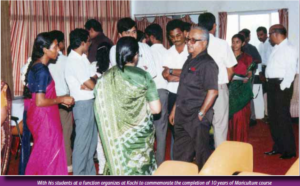
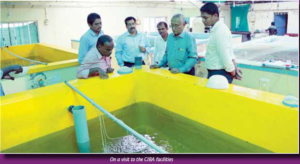
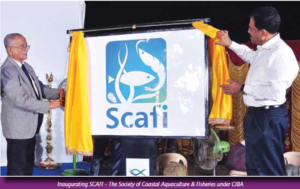
Global clout
Dr. Silas has chaired or participated in a number of National level policy making and academic committees and represented India at a number of International meetings, a few of which have already been mentioned here. In spite of his various commitments, Dr. Silas has all the way through pursued his research interests and has published nearly 300 scientific papers and monographs during his research carrier of over sixty years. Recently he chaired the national Task Force on “Guidelines for the Green Certification of Freshwater Ornamental Fishes” under the auspices of the Marine Products Export Development Authority (MPEDA), which should go a long way in regulating and implementing protocols in the nascent aquarium trade of ornamental freshwater fishes both within the country and for exports. MPEDA is spearheading this programme and also developing support units at the State level besides seeking interorganizational co-operation.
Dr. Silas has contributed his books, journals and publications of over 5000 numbers and reprints to the RGCA Library. This invaluable contribution and his caring and sharing way of life has been an asset to all those who are associated with RGCA.
Dr. Silas says that he owes a lot to his parents for the great confidence reposed in him during his early wandering years. He is ever grateful to his three mentors, Dr. Sunder Lal Hora, Dr. A. Salim Ali and Dr. Carl L. Hubbs. The strong support he has received from his family, especially his wife Mrs. Saradha Silas. He is survived by his wife Saradha Silas and three children, Dr.Geeta Silas, Mr. Ramesh Silas and Dr.Arun Silas.
It is a deep personal loss to me and Aquaculture Spectrum. However, his ideas and thoughts live with us and is something that will be remembered for all times to come.
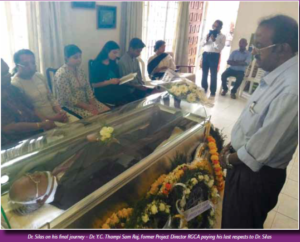
Prepared by Jaideep Kumar with inputs from Dr. Silas and CMFRI & CIBA
FOND REMEMBRANCES FROM THE SCIENTIFIC COMMUNITY
Dr. E. G. Silas, Father of Indian Aquaculture
At a juncture where India stands tall among the shrimp farming nations across the world producing over half a million tons of farmed shrimp, I feel that it is the vision and dream of Dr. E.G. Silas, of India becoming a superpower in Aquaculture, that has materialized. The systematic way in which he created, over a period of time, several premier R & D institutes in the field of Aquaculture & Fisheries Research and conceived Post Graduate and Doctoral programme in Mariculture is the handwork of a visionary. Way back in the 80’s, he initiated studies on reproductive biology, physiology, nutrition, fish health and genetics; all the different facets of shellfish and finfish aquaculture. It is the fruits of his futuristic vision that we see today, when Indian aquaculture production is poised to scale a million tonnes. Dr. Silas was a great mentor, and for his students, he doubled up as a friend, philosopher and guide, with immense warmth and care under a mask of seriousness and discipline. We, his Mariculture students were fortunate to experience this one way or other, be it in the lab, in field or even as a guest at his house. As a Ph.D. scholar of the Mariculture programme at CMFRI in early eighties, we all shared his dream. Dr. Silas, the father of Indian brackishwater and Mariculture, lives in the heart of all those in the sector, and this sector is indebted to him, a true legend in science and administration. Dr. Silas visited CIBA last May and even at the ripe age of 89, he was still curious to learn and discuss about the latest activities being pursued by CIBA on the developments in Brackishwater aquaculture, and discussed in length, like a beginner. He was also the founder Director of CIBA. We, his students and the industry owe a lot to this great man and will miss him. I pray for the departed soul and convey my heartfelt condolences to Dr. Silas’ family.
Dr. E. G. Silas, Renowned Marine Biologist
It is with a feeling of sadness that, I share with you my memories of Late Dr. E. G. Silas.
Silas sir is known to me since 1985 when I joined CMFRI as a SRF to pursue Ph. D. in Mariculture. Even before our personal association, I knew sir, as the renowned Marine Biologist who did his post-doctoral work both as Fulbright and Rock- Feller Fellow with Dr. Carl L Hubbs in Scripps Institution of Oceanography, CA and as a great scientist who described more than 23 new species of fish to the Science.
As the Director of CMFRI he upgraded the CMFRI to a world class centre of Research, Training and Extension. He had also contributed significantly to the development of CIBA in Chennai, CARI in Port Blair and RGCA. Dr. Silas was also instrumental in developing three national research centres, namely The Salim Ali Centre for Ornithology and Natural History, CMLRE and the NBFGR. The role he played in the upliftment of KAU to one of the best agricultural universities in India was another feather in his cap.
With more than 300 research publications and as a dedicated supervising teacher to many students and scientists for their successful completion of their Ph. D., his illustrious career was also marked by membership in many national and international committees. Among his accomplishments, the thing that I value most is the effort that Dr. Silas put in to develop higher education in Mariculture and fisheries in India. The Centre of Advanced Studies in Mariculture that he started at CMFRI in 1979 for Masters (M.Sc. Mariculture) and Doctoral (Ph.D. Mariculture) Degree programmes with aid from UNDP/FAO/ICAR has grown to greater heights which gave a real boost to India’s sea fish farming research and industry.
I am proud to say that I was one of his students for the Ph. D. Mariculture programme, and today I write this on Dr. Silas not as the Director of CMFRI, but as a representative of his student community. Always he had a soft corner and deep affection for his students. Sir had pride in introducing us as his student, even before we introduced ourselves. Always safe guarded us, right from our student days, till his last breath. He took care of us as a father, and as Godfather, guiding and mentoring us to where we are now. We have to celebrate him for his great vision that has really helped the Indian Aquaculture industry to grow several folds. He is living in all of us to guide us eternally.
There are several areas of research that was initiated in India when nobody even thought about such fields – including Mariculture, Tuna Fisheries in the Indian seas, Marine mammal research, Ecosystem based Fisheries, Satellite Remote Sensing Techniques in Fisheries, Concept of FGR, Green Certification of freshwater ornamental fish, tuna bait fish culture and soon. His contributions to building up Indian Aquaculture will always be remembered. His legacy will live on for years to come.
I am indebted to Silas sir for all the guidance and corrections that he has given me throughout my career. I truly feel blessed and honoured that Dr. Silas was an integral part of my life. My humble prayer to the Almighty is that the departed soul may rest in peace. I also pray that, the God Almighty give strength and courage to the family to outlive the great loss.
Dr. E. G. Silas, a strong man of conviction and vision
Dr. Eric Godwin Silas, will remain known for a legacy of passionate working, diligence for his responsibility in official capacity and societal benefits through upkeep of knowledge. A strong man of conviction and vision, enthused generations of fisheries scientist and entrepreneur. If India is transformed as leader in aquaculture and fisheries exports, infusion of knowledge based management is hugely responsible through the specialized manpower available. This is the outcome of his vision as‘Guru’ which brought in specialized trained ‘Mariculturists’ who are today brilliantly spread on the canvas of research to aquaculture business.
I personally feel proud to be a tiny part of the process, to carry forward the Guru’s legacy. Beyond this also, myself personally and ICARNBFGR has more reasons to feel connected to Dr. Silas. This is for his first love for fish taxonomy and educated to become legendry phylogeographist. This era started with his grooming under the guidance of Late Prof. Sunder Lal Hora, the then Director of the Zoological Survey of India. Dr Silas carried out explorations in the Western Ghats from Tapti River southwards to Kanyakumari to study the hill stream fishes. His revision of fish taxa from the rivers and lakes of the Himalayas, Central Asia – eastwards to China and south to Myanmar, Malaysia and Indonesia combined with his work on fishes from the Western Ghats helped him to contribute to Hora’s Satpura Hypothesis of the occurrence of fishes of Malayan affinities in the Western Ghats. His publications on the subject during 1950-1960 are highly inspiring. His work enthused us to carry explorations in some rivers of Peninsular India. This led to discovery of a new undescribed species of genus Pangasius. This was our tribute to him by naming the fish “Pangasius silasi”, second fish of this genus in whole South Asia. I feel satisfied that atleast ICAR-NBFGR could put the species with his name, to the academic world during his lifetime, to prove him right, as he suspected second species of Pangasius.
Dr. Silas carried immense respect to his ‘Guru’, which at ICAR-NBFGR, we could understand, when he delivered ICAR-NBFGR – 25th Anniversary Lecture at Lucknow. Dr. Silas in his lecture during 25th Anniversary Celebrations at Lucknow in April, 2008 spoke on phylogeography of fishes, inspiring youngsters and glimpses ‘Phylogeograhpy of NBFGR”. Today, when FAO is preparing beginning the minimum framework on Aquatic Genetic Resource Management, India has an experienced full-fledged institution on Aquatic Genetic Resources Management which is ICAR-National Bureau of Fish Genetic Resources. Historically, it was a surprise to many, in a FAO conference, when Dr. Silas proposed that countries will need such institutes in future, to handle research in this area. His proposal metamorphed and evolved into this institute. Nothing more is required to prove the depth of his vision, as time
itself has witnessed thoughts taking shape of functional structures. He guided ICAR-NBFGR in the capacity of Chairman, Research Advisory Committee and Quinquennial Review Team. He is always remembered for his positive outlook, sharp and conclusive views and guidance. He will be remembered always as the legacy in the form of intellectuals, he generated will be dynamic and moving.
Source: Aquaculture Spectrum
